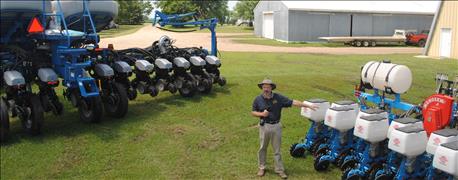

PROGRESSION OF RESEARCH: At a field day tour last summer near Beresford, S.D., Peter Sexton, SDSU Southeast Research Farm supervisor, talks about the progression of multi-hybrid technology from the retrofitted Monosem planter (right) to the new Kinze unit (left).
Nebraska researchers have been busy lately planting test fields utilizing multi-hybrid planting systems in eastern Nebraska. Multi-hybrid planting is a system that allows two seed varieties to be planted in the same field with one planter pass, switching between varieties according to varied soil types and terrain. The advantages of this system seem to depend on the year. When farmers are experiencing optimal growing conditions, multi-hybrid planting may not pay off with higher yields. When there is greater variability in weather and soil types across the field, it may boost yields by as much as five to eight bushels per acre on corn and two to three bushels per acre on soybeans, says Peter Sexton, South Dakota State University Southeast Research Farm supervisor.
With much of the earliest trials on multi-hybrid planting conducted by SDSU, Sexton and his team are going into their fourth year of research. And this spring, University of Nebraska graduate student, Rachel Stevens, is working with producer-cooperators to gauge how well the multi-hybrid system works. There are five corn sites on 300 acres and three soybean locations on 120 acres in eastern Nebraska utilizing Kinze's new multi-hybrid planter. Stevens says that corn sites will be tested for optimizing hybrid placement for water availability across the field. In soybean fields, researchers are taking a multiple treatment approach for each site specifically applying seeds treated with ILeVO to combat Sudden Death Syndrome. "Management zones have been defined based on multiple spatial layers including yield history, electrical conductivity data and aerial imagery," Stevens says. "Each zone has been assessed for yield performance and a specific hybrid or treatment assigned to it. Within each zone, we have several check strips of the 'off' treatment in order to assess optimum hybrid or product performance and conduct economic analysis on hybrids and treatments."
~~~PAGE_BREAK_HERE~~~
"If you have good conditions, it really doesn't matter," Sexton says. "Last year at the Southeast Farm near Beresford, S.D., we had an extra seven inches of rain in July and August, so everything looked good. But the more variability there is in the field, the more likely it is to give a yield advantage."
In the spring of 2012, SDSU staff worked with Raven Industries to retrofit a Monosem planter with a twin-row configuration which was customized with hydraulic drives, a control system and software to allow the planter operator to switch between planting two different varieties on the go as it planted in different locations and soil types. Last year, SDSU utilized the Kinze multi-hybrid planter that offers almost seamless planting between two varieties with so much precision that observers cannot tell by seed spacing where one variety ended and the other started in a row. SDSU research most recently has focused on finding the correct varieties to perform under lowland and upland conditions, Sexton says.
In lowland portions of the field, varieties are planted that have a stronger disease resistance package, more horizontal root profile and thrive better in wetter conditions. On upland portions of a field, varieties that withstand drought stress and drier conditions with a stronger vertical root profile are planted.
"We know the technology is there; these systems are quite capable of switching between hybrids accurately as we move into different management zones," Stevens says. "But how do we determine those zones? What spatial layers do we need and across how many years?" Once UNL researchers have some confidence with management zones, they will look at characteristics needed for placing the right hybrids in the correct zone. "These are all questions that producers have about adoption of this technology," she says.
About the Author(s)
You May Also Like






